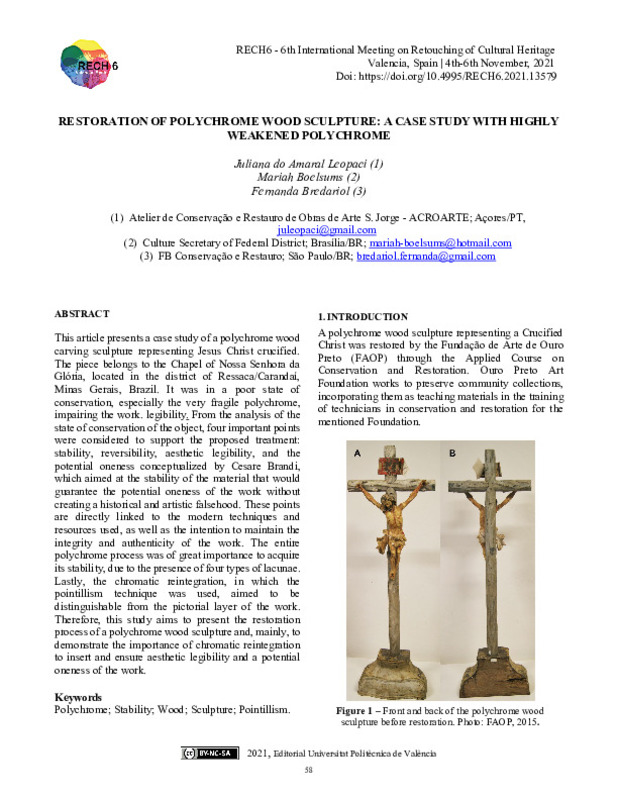JavaScript is disabled for your browser. Some features of this site may not work without it.
Buscar en RiuNet
Listar
Mi cuenta
Estadísticas
Ayuda RiuNet
Admin. UPV
Restoration of polychrome wood sculpture: a case study with highly weakened polychrome
Mostrar el registro sencillo del ítem
Ficheros en el ítem
| dc.contributor.author | Leopaci, Juliana
|
es_ES |
| dc.contributor.author | Boelsums, Mariah
|
es_ES |
| dc.contributor.author | Bredariol, Fernanda
|
es_ES |
| dc.date.accessioned | 2023-02-03T08:41:44Z | |
| dc.date.available | 2023-02-03T08:41:44Z | |
| dc.date.issued | 2023-01-11 | |
| dc.identifier.isbn | 9788413960258 | |
| dc.identifier.uri | http://hdl.handle.net/10251/191591 | |
| dc.description.abstract | [EN] This article presents a case study of a polychrome wood carving sculpture representing Jesus Christ crucified. The piece belongs to the Chapel of Nossa Senhora da Glória, located in the district of Ressaca/Carandaí, Minas Gerais, Brazil. It was in a poor state of conservation, especially the very fragile polychrome, impairing the work. legibility. From the analysis of the state of conservation of the object, four important points were considered to support the proposed treatment: stability, reversibility, aesthetic legibility, and the potential oneness conceptualized by Cesare Brandi, which aimed at the stability of the material that would guarantee the potential oneness of the work without creating a historical and artistic falsehood. These points are directly linked to the modern techniques and resources used, as well as the intention to maintain the integrity and authenticity of the work. The entire polychrome process was of great importance to acquire its stability, due to the presence of four types of lacunae. Lastly, the chromatic reintegration, in which the pointillism technique was used, aimed to be distinguishable from the pictorial layer of the work. Therefore, this study aims to present the restoration process of a polychrome wood sculpture and, mainly, to demonstrate the importance of chromatic reintegration to insert and ensure aesthetic legibility and a potential oneness of the work. | es_ES |
| dc.format.extent | 7 | es_ES |
| dc.language | Inglés | es_ES |
| dc.publisher | Editorial Universitat Politècnica de València | es_ES |
| dc.relation.ispartof | 6th International Meeting on Retouching of Cultural Heritage, RECH6 | |
| dc.rights | Reconocimiento - No comercial - Compartir igual (by-nc-sa) | es_ES |
| dc.subject | Potential unit | es_ES |
| dc.subject | Chromatic reintegration | es_ES |
| dc.subject | Wood carving | es_ES |
| dc.subject | Polychromy | es_ES |
| dc.subject | Pointillism | es_ES |
| dc.title | Restoration of polychrome wood sculpture: a case study with highly weakened polychrome | es_ES |
| dc.type | Capítulo de libro | es_ES |
| dc.type | Comunicación en congreso | es_ES |
| dc.identifier.doi | 10.4995/RECH6.2021.13579 | |
| dc.rights.accessRights | Abierto | es_ES |
| dc.description.bibliographicCitation | Leopaci, J.; Boelsums, M.; Bredariol, F. (2023). Restoration of polychrome wood sculpture: a case study with highly weakened polychrome. En 6th International Meeting on Retouching of Cultural Heritage, RECH6. Editorial Universitat Politècnica de València. 58-64. https://doi.org/10.4995/RECH6.2021.13579 | es_ES |
| dc.description.accrualMethod | OCS | es_ES |
| dc.relation.conferencename | RECH6 - 6th International Meeting on Retouching of Cultural Heritage | es_ES |
| dc.relation.conferencedate | Noviembre 04-05, 2021 | es_ES |
| dc.relation.conferenceplace | Valencia, España | es_ES |
| dc.relation.publisherversion | http://ocs.editorial.upv.es/index.php/RECH/RECH6/paper/view/13579 | es_ES |
| dc.description.upvformatpinicio | 58 | es_ES |
| dc.description.upvformatpfin | 64 | es_ES |
| dc.type.version | info:eu-repo/semantics/publishedVersion | es_ES |
| dc.relation.pasarela | OCS\13579 | es_ES |








